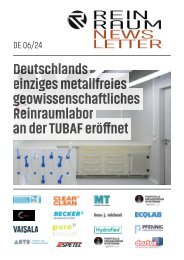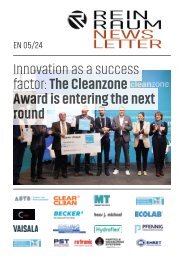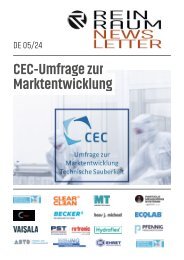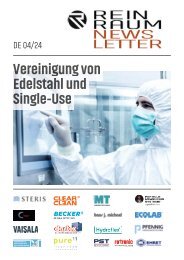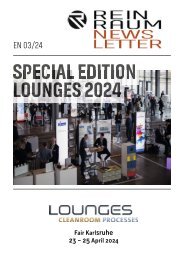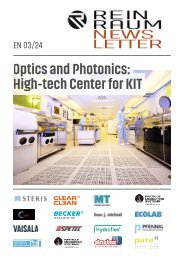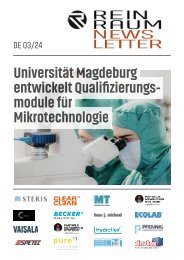Newsletter_07-2024_EN
You also want an ePaper? Increase the reach of your titles
YUMPU automatically turns print PDFs into web optimized ePapers that Google loves.
Quantum sensor improves<br />
process and quality control<br />
by analyzing particles in real time<br />
The properties of raw materials and feedstock<br />
play a decisive role in analysis and production<br />
processes as well as in laboratory<br />
and process technology. Detailed information<br />
about the size, number, composition<br />
and distribution of particles contribute to<br />
process control and quality assurance. At<br />
Analytica in Munich, the Stuttgart-based<br />
high-tech start-up Q.ANT is showcasing a<br />
compact particle sensor for industrial applications<br />
that can be used to monitor these<br />
parameters in real time. The patented sensor,<br />
which is based on quantum technology,<br />
offers real added value for numerous sectors:<br />
from additive manufacturing, biotechnology,<br />
the ceramics industry, the materials<br />
and chemical industry to water treatment,<br />
medical technology and cosmetics.<br />
Accelerated shape detection without<br />
camera<br />
Instead of taking samples and analyzing<br />
them in the laboratory, which is still standard<br />
in many industries, users receive immediate<br />
feedback on the quality and composition<br />
of ingredients. The sensor detects<br />
and analyses particles in raw materials and<br />
feedstocks, regardless of the medium, which<br />
can be liquid, gaseous or powdery. Process<br />
monitoring, process optimization and quality<br />
control are thus possible in real time. In<br />
addition to the size, number and distribution<br />
of individual particles, the sensor developed<br />
by Q.ANT will also be able to classify particle<br />
shapes in real time in the future. This is<br />
made possible by the quantum technology<br />
used in conjunction with an AI that can be<br />
trained to differentiate between predefined<br />
shapes, such as elliptical or spherical particles<br />
and round particles, which can also<br />
be used to identify agglomerates. For this<br />
purpose, the AI must be trained for specific<br />
“use cases”.<br />
Numerous fields of application<br />
There are many industries and fields of application<br />
for the particle sensor, which can<br />
also be used in combination with other<br />
measurement methods and mechanisms.<br />
The quantum particle sensor detects and classifies the particles in liquids, gases or as<br />
powders according to size, number, composition and, in future, shape.<br />
For example, the quantum sensor can monitor<br />
algae cells in bioreactors and recognize<br />
dead cells as soon as they change their shape.<br />
The system control can then intervene to<br />
regulate the process without having to take<br />
samples from the reactor. Another example<br />
is water treatment: the AI recognizes<br />
contamination, for example by bacteria or<br />
other organisms that are difficult to detect,<br />
which allows conclusions to be drawn about<br />
the purification process. In additive manufacturing<br />
using 3D printing, as well as in the<br />
metal, ceramics and cement industries, the<br />
quantum sensor analyses different powder<br />
granulations, which can result in specific<br />
material properties. Other conceivable areas<br />
of application are the chemical and cosmetics<br />
industries, including pigment analysis<br />
for the development of colors and textures.<br />
Q.ANT offers partnerships for specific<br />
applications<br />
In order to develop specific applications,<br />
Q.ANT offers partnerships to interested<br />
companies. “We offer the industry early<br />
access to this new solution for particularly<br />
challenging problems without having to go<br />
through long development cycles,” says Vanessa<br />
Bader, Customer Project Engineer at<br />
Q.ANT. “Our partners have the opportunity<br />
to work with us to integrate the quantum<br />
sensor into their production processes and<br />
adapt it to their applications.” Q.ANT, which<br />
has patented the new technology, currently<br />
offers two particle sensors with different<br />
measuring ranges: from 2 to 50 micrometers<br />
and from 20 to 700 micrometers “With this<br />
range, we cover most applications in industrial<br />
production,” says Bader. Pilot projects<br />
indicate very high data quality. For example,<br />
the AI can distinguish particle agglomerates<br />
in metallic powders from individual particles<br />
that are just as large.<br />
The compact sensor is easy to handle and<br />
quick to integrate<br />
Another advantage: the compact quantum<br />
sensor fits on any laboratory bench and the<br />
system is quicker and easier to handle compared<br />
to the time-consuming conventional<br />
sampling process for analyzing particles. In<br />
addition to the laboratory device, feeding<br />
systems are being developed in the partner<br />
program to integrate the sensor inline into<br />
processes. A normal computer is all that is<br />
needed to transfer and visualize the measured<br />
data. The sensor is immediately ready<br />
for use via a website in the browser. “Nothing<br />
needs to be installed, you don’t need<br />
any extra computing power or complicated<br />
training for employees,” explains Bader.<br />
Q.ANT GmbH<br />
D 70565 Stuttgart<br />
www.reinraum.de | www.cleanroom-online.com NEWSLETTER | Edition <strong>EN</strong> <strong>07</strong>-<strong>2024</strong><br />
page 3/28








